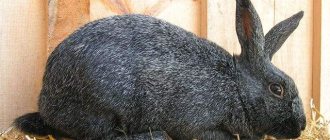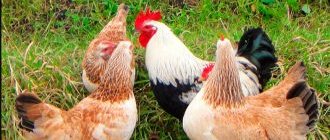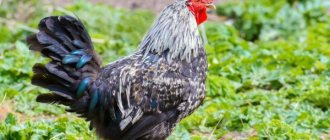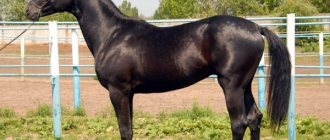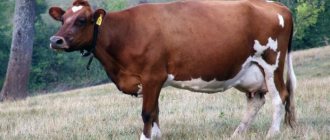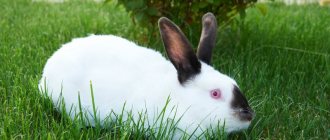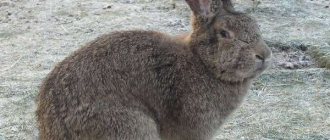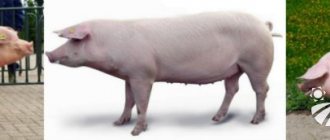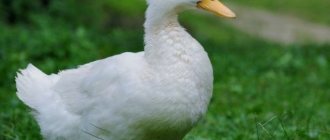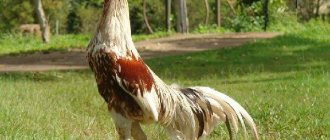Breeding and keeping Pannon rabbits
Pannon White rabbits are not a capricious breed; they quickly get used to the diet and food they are given.
With an average calculation, up to four kilograms of feed are consumed per kilogram of weight. A properly formulated and dosed diet will result in weight gain of forty grams or more. In general, they are less mobile than the rest of their relatives, so they gain weight faster and have a good layer of fat more often, which means less feeding costs. The fur on their paws is well defined enough to warrant keeping them in a cage with a mesh floor, whereas in other breeds, such flooring injures the paws and causes plantar dermatitis, which can be fatal.
Rabbits have distinct colors
This animal does not need large spaces; it feels comfortable in heat and cold. The habitat should be well ventilated, but drafts should not be allowed. Make sure that there are no mice, rats, or other rodents in the cages - they are carriers of infection, and rats can eat small rabbits. Do not forget to regularly clean the cages, disinfect feeders and drinking bowls every 10-12 days, thoroughly clean the room where the animals are kept and wash equipment. It is necessary to be vaccinated and vaccinated.
If you properly care for albinos, they will always eat willingly, have smooth, shiny fur, clear eyes and nose, and will not be lethargic. A healthy animal has a body temperature in the range from 38.5 to 39.5 degrees, a pulse of 120-16 beats per minute, a respiratory rate per minute of 50-60 inhalations/exhalations. 90 days after birth they can be prepared for slaughter.
Pannonian Breeding
For large farms and even for beginning rabbit breeders, breeding the albinos described above is an excellent option. They are easier to breed because after three months of life, the females are ready for fertilization. They can give birth to rabbits up to six to seven times a year, and six to nine babies are born at a time. Female rabbits, having ten nipples, can feed not only their own offspring, but also someone else's - they always have a lot of milk and they are unusually caring mothers, ready to accept the offspring of another female.
On the forums, positive reviews from farmers about this breed are confirmed by the demonstration of photos in which babies weigh 300 grams at 15 days, 700 grams per month, after 75 days from birth - 2.5 - 3 kg, and adult animals already reach 4.5 – 5 kg.
Breeding the White Giant breed
The “white giant” breed is considered one of the most popular among those who breed rabbits. These animals produce the most tender meat, and their skin, which is very large in size, is suitable for sewing fur coats. Regarding the latter, we can give advice: do not allow excessive fluffiness. Rabbits that have fluffier fur than prescribed by the standards can be safely discarded - this is a breed defect.
One of the main advantages of white giants is the fact that the female rabbit does not eat her offspring, but cares for them and provides adequate feeding. In this regard, the litter - usually 7-9 cubs - is separated at the age of two months. Just at this time, the female white giant stops feeding.
Rabbits must be kept clean; cleaning and disinfection should not be neglected. Do not forget to monitor the health of your pets - white giants are susceptible to fruit dermatitis and mastitis; if the first signs of these diseases appear, you should immediately contact a veterinarian.
Keeping rabbits in cages
Several rabbits - White Giant
The white giant's solid coat protects it from hypothermia, so the cage does not need to be further insulated - the main thing is to eliminate drafts. Also, you should not place it in the sun; the best option would be a place in the shade. The cage should be spacious; the animal does not tolerate crowding.
Due to the heavy weight, calluses may appear on the white giant's paws, to prevent which it is necessary to pay considerable attention to the floor of the cage. It is best if it is smooth and solid, or, in extreme cases, wooden. The cage doors are made of mesh material (the lumen of the cells should not exceed 2x2 cm)
In winter, they can be hung with burlap to protect the rabbits from gusts of cold wind. As drinking bowls and feeders, you can use containers that are easy to clean - for example, metal bowls
The cage doors are made of mesh material (the lumen of the cells should not exceed 2x2 cm). In winter, they can be hung with burlap to protect the rabbits from gusts of cold wind. As drinking bowls and feeders, you can use containers that are easy to clean - for example, metal bowls.
Contents of the queen cell
When arranging the cage, we must not forget about the queen cell - after all, sooner or later the female will bring rabbits. The queen cell is prepared 7-10 days before birth, observing a number of strict requirements:
- It should be located on the side of the cage and have standard dimensions: height - 35 cm, length - 60 cm, width 30 cm;
- To simplify inspection of the nest and brood, a removable lid is placed on top;
- The cage must be two-story, with the second floor needing special protection.
In addition to the above features, all the rules for equipping a common cage are also relevant for the queen cell.
Rabbit nutrition
White giants can buy ready-made food, or you can prepare it yourself - and the latter option is much more profitable. This breed is very unpretentious in food and boasts an excellent appetite. What can you feed these animals? Some of their favorite dishes include:
Photo White Giant eats grass
Grass, including tops;
Various vegetables - carrots, cucumbers, pumpkin, cabbage, corn, peppers, salads; Well dried hay; Cereals.
Many owners prepare a kind of vinaigrette for their white giants:
- Carefully chop and mix vegetable and fruit waste.
- Place tightly in an enamel bucket and pour boiling water over it.
- Cook the mixture for two hours.
- Drain off any unnecessary liquid and cool the resulting salad.
Rabbits also do not refuse bread dipped in milk. With adequate nutrition, white giants grow and become stronger quite quickly - for example, the body weight of a four-month-old rabbit can reach four kilograms.
In summer, it is recommended to take animals to natural pastures, avoiding places where poisonous plants may grow. In the spring, the use of special vitamin supplements is allowed - this will save rabbits from seasonal vitamin deficiency. To maintain normal functioning of the digestive tract, it is advisable to periodically provide hard foods - for example, crackers.
There should always be water in the drinking bowls, but some individuals may refuse it - this means that the diet completely saturates the animal’s body with liquid.
Often, white giants are kept at home as decorative animals, and in this case they also need proper care. Follow the rules of keeping - and the animal will certainly meet all the expectations placed on it.
Watch the video - White Giant rabbit (feeding dandelions)
kroliki-prosto.ru
Rabbit nutrition
White rabbits eat the same as other breeds, but due to their size, they need more food. The diet of eared animals contains:
- Concentrates. You can give the animals such food in the form of granules or harvest grain crops yourself. Grain is better absorbed when sprouted or steamed.
- Hay. In winter, hay replaces lush grass, but in summer it should also be offered to pets, because it improves digestion and helps grind teeth.
- Vegetables. Rabbits should get vegetables, because they are a source of vitamins. The animals are given carrots, sugar or fodder beets, zucchini, cucumbers, and Jerusalem artichoke.
- Branches. Rough food should always be on the rabbit menu. By eating branches of trees and bushes, rabbits wear down their constantly growing teeth.
- Grass. In summer there is enough such food, and rabbits love it very much. Grass is a source of microelements and vitamins. Before distributing the greens, let them lie in the shade for several hours so that the concentration of esters in them decreases.
- Legumes. It is worth giving your pets legumes – peas and corn – in small quantities.
Peas for rabbits
Rules of care
Keeping animals does not cause any problems: they take up little space and feel good in a cage with a mesh bottom. The edges of their paws allow them to move easily on such sections, whereas other breeds are not adapted to this type of floor. It injures their paws and causes plantar dermatitis, which can be fatal. They are also unpretentious to temperature conditions: they feel equally good in both hot and cool rooms.
It is necessary to maintain the proper level of hygiene: make sure that the cages do not house mice and other rodents that are carriers of diseases. Large rats can even eat small rabbits. Regular cleaning and disinfection of feeders and drinkers at least once every 10 days are the basic standards for caring for rabbits of this breed. Timely vaccination and proper maintenance will provide your pets with smooth, shiny coat, neat eyes and nose, mobility and a cheerful state.
White Pannones are unpretentious to temperature conditions
Feeding
The White Pannon's high adaptive abilities and the absence of any taste preferences greatly facilitate the feeding process. In addition, the rabbit quickly gets used to any routine, which makes it possible to adjust the rabbit’s diet to its own schedule. Feed consumption is relatively small: for 1 kg of weight, approximately 4 kg of food is consumed, and weight gain is 40 g per day. As you can see, you can achieve good results with minimal costs.
Rabbits of the White Pannon breed are not picky eaters.
It is advisable to use high-quality feed, a large amount of hay and vegetables. A few drops of iodine can be added to drinking water to prevent coccidiosis. And to increase fertility, it is recommended that rabbits dilute apple cider vinegar in their drink in a ratio of 3 drops per 1 liter of liquid. A healthy rabbit needs food about 80 times a day! Accordingly, it should be ensured that food is always readily available to the animal.
In order for rabbits to delight you with excellent productive performance, the basis of their nutrition should be:
- vegetables: sugar beets and potatoes;
- cake;
- grain crops;
- legumes: beans and peas;
- compound feed;
- clover and alfalfa;
- silage from fodder cabbage and carrots;
- legume-cereal hay.
If we take the annual norms for the purchase of provisions, then depending on the life cycle of the animal, within 1 year you will need for one individual:
| Volume, kg | Animals in the non-breeding period, 33 days | Rabbits in breeding period, 32 days | Pregnant rabbit, 120 days | Lactating female, 180 days | Young animals, 75 days | Replacement rabbit, 42 days |
| Concentrate | 3,5 | 4 | 17 | 62 | 10 | 5 |
| Hay | 1 | 1,5 | 6 | 21 | 3 | 2 |
| Silage | 3 | 4 | 15,5 | 57 | 2 | 5,5 |
| Green food | 4,5 | 5,5 | 23 | 83 | 12 | 8 |
How to set up a rabbitry
Rabbit breeding requires extreme care, hard work and dedication from the owners of rabbit mini-farms. Before you get furry pets, you need to provide them with a comfortable home. In order for the long-eared livestock to be comfortable in the rabbitry, care should be taken to ensure good lighting, appropriate hygiene and high-quality ventilation.
Most farmers have long given up keeping rabbits in barns. This option is not popular due to the fact that it is not possible to fully control the litter. It is much more effective to keep animals in cages with different functionality: separate enclosures for different groups of rabbits.
The most common options are a heated enclosure and a shad canopy, which involves the use of cages on several levels. This design is quite convenient: it allows you to optimize the process of cleaning and feeding feed, ensure comfortable wintering and economically use the occupied space.
Scheme of a rabbitry with a shed canopy
External view of a rabbitry with a shed canopy
A typical cage for mature livestock has the following parameters:
- length: from 80 to 130 cm;
- width: from 60 to 80 cm;
- height: from 40 cm.
When setting up a rabbitry yourself, wood is often used. Despite the inexpensive cost of this material, it quickly becomes damp and wears out. The metal version is much more convenient. In addition to its long service life, it makes it possible to reduce damage from rats. It is preferable to build a cage with a horizontal orientation. You should not make it deep - it will be difficult to get your pet out of there. It is advisable to make the floor from first-class concrete, since the wooden base over time turns into a source of infections and harmful bacteria.
Rabbit option
Advantages
White Pannon rabbits have also gained popularity because they are unpretentious to living conditions, adapt well to any climate and can easily tolerate both cold and heat, and this makes it possible to place cages even outside. Animals do not need a lot of space, which is also a big plus, because more animals can be accommodated in a smaller area.
Cleanliness is important to Pannon, which is why it is simply necessary to constantly clean, change the bedding and wash the drinkers and feeders. It is also advisable to carry out the disinfection procedure for places of detention at least once a month.
The right choice of housing would be a cage with a mesh floor, which is easy to make even yourself; you should place a tray underneath for litter.
Such a character trait of Pannon as friendliness makes it possible to populate cages with a sufficiently large number of individuals, but one must also remember that overcrowding leads to the impossibility of getting fresh air, and this is dangerous for the health of the animals and entails the development of unpleasant diseases.
When it comes to cell sizes, there are certain standards. For example, their length should be at least 90 cm and no more than 1.5 m, and their width should be from 70 cm to 90 cm. For a height of 40 cm it will be quite enough. Floor placement requires the construction of several separate enclosures to control mating. If you adhere to these requirements, there is a risk of complete degeneration of the species. It also makes sense to create an additional room where you can take your pets while cleaning.
Advantages and disadvantages
The breed has undeniable advantages:
- Early maturing breed. With optimally selected nutrition, animals rapidly gain strength and enter the ripeness phase. Slaughter is possible starting from 4.5 months.
- Low consumption of feed material. Individuals, compared to other meat breeds, eat little. The amount of feed fed is influenced by the fact that due to precocity, the life of animals is short.
- Excellent quality criteria for fur. Among meat breeds, this one has the highest quality skin. The fur is beautiful, thick, similar to elite fur. You can read about how to tan rabbit skin at home here.
- Simple care and maintenance measures. The breed is famous for its unpretentiousness. They do not require special housing conditions or excess feed. In terms of health, the animals do not suffer from problems.
Vienna Blue has no obvious disadvantages. Possible breeding problems include:
- the possibility of falling into depressive and stressful states;
retaliatory aggression as a defensive reaction; Graying of fur in adults over 4-5 years of age.
Watch the video for an overview of the Vienna Blue rabbit breed:
Why is it worth breeding?
According to reviews, Pannon rabbits have the following advantages:
- precocity;
- excellent fertility;
- unpretentiousness;
- rapid adaptation to environmental conditions;
- tasty meat and its high yield;
- high productivity;
- calm character.
And, of course, an important advantage of the breed is that it can be bred even on small farms. For example, in the summer in a country house or in a village, having only one male and 3-4 females.
This is due to the fact that reproduction occurs naturally. One male can even fertilize several females. It is precisely because of these advantages that when choosing a broiler breed, preference can be given to Pannon rabbits.
How to remove fleas from a rabbit at home, read our article.
Breed description and characteristics
Rabbits of the Pannon breed are broiler breeders, i.e. they are bred for slaughter for meat. This species was bred in Hungary at the Agricultural Academy. St. Stephen. The following varieties were taken as a basis: Californian, New Zealand, and white giant. In a short time, the White Pannon rabbit breed has become very popular on farms. Such a high demand for it is due to the good milk production of females, large litter size, and rapid weight gain.
White pannon rabbit characteristics:
- weight – about 5 kg;
- how many times a year the female brings offspring - up to 7;
- what daily weight gain is considered normal - 40 g;
- how many rabbits in one litter - up to 9;
- feed consumption per 1 kg – 4.2;
- At what age can you be sent to slaughter - 3 months;
- meat yield - up to 62% (the rest comes from bones, internal organs, skin).
White Pannon rabbit breed description:
- body length – 60 cm;
- the body is elongated, the muscles are clearly visible;
- miniature head;
- the muzzle is slightly extended forward, pointed;
- big nose;
- snow-white fur, without color impurities, red eyes (a sign of albinism);
- thin skin that fits tightly to the body;
- light skeleton;
- erect ears of medium size with abundant pubescence;
- paws of medium length, well developed, strong.
Expert opinion Dobryshev Sergey Anatolyevich Professional rabbit breeder with 30 years of experience
Note! The description of Panon rabbits is quite similar to other breeds. For example, with one of his ancestors, a white giant.
Rice. 2. Photo of a female white pannon with a litter.
Video: differences from the white giant rabbit
It is recommended to compare the characteristics of the White Pannon rabbit breed with a similar species in the video: https://www.youtube.com/watch?v=MnopuBMfkzM.
Features
The popular White Pannon breed belongs to the widely sought-after broiler type. A hybrid variety of rabbit was developed in Europe, Hungary, within the walls of the St. Istvan based on the White Giant, Californian and New Zealand. The resulting cross was duly appreciated in profiling circles. The excellent reputation and boom in farming circles are explained by high milk characteristics, rapid weight gain and excellent fertility rates.
Pedigree of the White Pannon
Basic standards:
- weight - about 5 kg;
- annual number of litters – up to 7;
- norm of daily weight gain - from 40 g;
- the number of cubs in one litter is up to 9 individuals;
- feed consumption per 1 kg – 4.2 kg;
- estimated age for slaughter – 90 days;
- meat yield – up to 62%.
White Pannon has high productivity characteristics
Rabbits of this variety have a long, elongated body and a neat, compactly folded head. They have a dazzling white color and red eyes, which indicate that they are albinos. Well-defined muscles, thin skin that fits tightly to the body, light bones, fluffy hair and medium-sized erect ears - representatives of this family are born quite strong and hardy. Other advantages include excellent growth rate, disease resistance and multiple births. Regarding this species, there is still debate between those who believe that the White Pannon is not a breed, but only an industrial hybrid, and lovers of the breed.
White Pannon rabbits are hardy and prolific
Video - How to distinguish the White Pannon rabbit from the White Giant rabbit
Often breeders are faced with the problem of separating rabbits of one breed from rabbits of another. To avoid getting into trouble when purchasing, watch this video.
Video - Young White Pannon at the age of 1.5 months
Is the White Pannon a breed, a line or a hybrid?
There is a strange phenomenon in rabbit breeding where some breeds are recognized by some national associations and not others. As a result, it is believed that the Hungarian White Pannon is not a breed, but a hybrid. An old story that is associated with incorrect translation of the description of the breed in the Russian segment of the Internet and illiteracy in interpretation. If you think that Pannon is a hybrid, then cross the rabbits of a male New Zealand white and a female Californian, dilute with a white giant and consider the young animals of these rabbits to be hybrids. Look at the crossbreeding. On the other hand, most domestic breeds are not recognized by foreign associations of rabbit breeders, however, the black-brown rabbit did not become a hybrid because of this, but was registered in the USSR (Russia) as an independent and fully established breed, for which the author, the former political Zeka, comrade. Stalin gave the prize in his name, and did not give a new term, as he sometimes did.
There are two types of hybrid rabbits:
- Simple hybrids in the first generation (industrial crossing). Look in the article about crossing breeds for ready-made diagrams of first-generation hybrids.
- Complex crosses (variable crossing), for example Hycole, Hy-plus, Kapital Hy-19, Zika rabbits, etc. - hybrids of the second and subsequent generations.
Complex hybrids (crosses) are produced according to a specific, patented scheme, and then the young males and females are sold to farmers for subsequent cultivation and crossing with each other. The offspring are used only for fattening and not for breeding.
The breed is a genetically stable type of domestic animal; with purebred crossing and proper grading, it retains its breed characteristics indefinitely.
I'll explain it more simply. To breed cross-breed rabbits, let's say Hikol. You need to definitely buy a male and a female. They are crossed (females and males carry genes from different breeds). Born offspring should only be sent for fattening and subsequent slaughter, and not for breeding.
Pannon rabbits are a breed, but without clear morphological standards (line), created exclusively for meat fattening
For farmers, it is not important that Pannon is recognized as a breed or line, all the same, the main thing is that these rabbits grow very well in fattening. When purchasing for a breeding purpose, they may give you hybrid cross-rabbits of the selection Hicol, Chi-plus, Capital Chi-19, Zika and others related to Pannons
In a zootechnical understanding, all breeds of rabbits are hybrids; they were obtained by mixing different breeds
- The first stage in breeding any breed is hybridization (crossing different breeds), isn’t it?
- The second stage of breeding any breed of animal is to consolidate the breed’s qualities, isn’t it?
In particular, Pannon is a hybrid of New Zealand, Californian and white giant. Is Pannon rabbit breeding then called crossbreeding? Let's study the materiel.
Character and behavior
Representatives of the Californian breed are usually calm and have an easy-going disposition. They remain relaxed in unfamiliar places and do not experience much stress. They are not apathetic individuals - they show curiosity and liveliness.
They have a gentle character and become attached to their owners without creating problems for them. Some fanciers keep them as pets and, along with their playfulness and friendliness, note the intelligence of the “Californians.”
Important! In apartment conditions, owners of such a pet as the California rabbit should take into account that he loves to chew on everything. When he walks freely around the living space, you need to keep an eye on him so that he doesn’t chew furniture or cables.
Female rabbits of the Californian breed are very caring “mothers” who can take care of their offspring themselves, without additional help.
Moreover, they can raise other people’s rabbits if they are placed in her cage.
Female rabbits of the Californian breed are very caring “mothers” who can take care of their offspring themselves, without additional help. Moreover, they can raise other people’s rabbits if they are placed in her cage.
What diseases may appear?
The Pannon rabbit is susceptible to viral diseases such as VGBV and myxomatosis. They can be identified by the following clinical picture:
- blue lips;
- hyperthermia;
- purulent discharge;
- swelling of the eyelids;
- itching;
- weakness;
- tumors;
- deterioration or complete loss of appetite;
- convulsions;
- hemorrhages;
- problems with the gastrointestinal tract.
Also, according to reviews, Panon rabbits are more susceptible to the following diseases:
- coccidiosis;
- fleas;
- worms;
- pododermatitis;
- lichen.
Expert opinion
Dobryshev Sergey Anatolievich
Professional rabbit breeder with 30 years of experience
Important! VGB and myxomatosis lead to death in most cases. Therefore, animals need to be vaccinated against these diseases in a timely manner. Of course, the procedure does not provide a 100% guarantee that the rabbits will not get sick, but it significantly reduces the risk of developing infectious lesions.
Breed characteristics
These rabbits are broiler breeds. Their characteristic feature is a very rapid gain of body weight with relatively low feed costs.
Did you know? Contrary to popular belief, rabbits are not rodents. They belong to the hare family and the order of mammals, have a different skeletal structure from rodents and an additional pair of incisors located behind the upper incisors.
Description of appearance
| Color | White |
| Torso | Extended |
| Head | Compact, with an elongated and pointed muzzle |
| Eyes | Of red color |
| Ears | Wide, protruding, dense |
| Mustache | Short, curved |
| Neck | Short |
| Paws | Strong, with well-developed muscles, well covered with fur. |
| Tail | Short, with a darker shade |
| Claws | Pink |
class="table-bordered">
This breed has much in common with representatives of another highly productive broiler breed - Hiplus. However, the white pannon also has significant differences:
- these rabbits do not require expensive feed;
- they gain weight more slowly;
- characterized by a higher level of fertility and an early period of maturation;
- have a higher percentage of body fat;
- White Pannon is suitable for breeding by novice rabbit breeders who do not have substantial starting capital.
Did you know? In the Inland Sea of Japan there is an island called Okunoshima, which tourists nicknamed Rabbit Island. They named it this way because it is home to a huge number of wild rabbits that are not afraid of humans. There is a ban on the import of cats and dogs on the island.
Character
By nature, these are calm, balanced individuals who do not cause problems when kept. Females are especially peaceful and friendly, which is manifested, in particular, in the fact that they are ready to feed not only their own children, but also other people's rabbits.
Productive qualities
Representatives of this breed gain 4–4.5 kg by the age of 3 months. This is sufficient to use them for meat. The slaughter yield is about 62%. The meat is characterized by excellent taste. The offspring is born weighing 45–50 g. The young gain 40 g per day.
Pros and cons of the breed
- Breeders of White Pannon rabbits claim that keeping them has only one advantage:
- precocity;
- rapid weight gain;
- good meat yield;
- high fertility (6–7 litters per year);
- high number of newborn rabbits (8–9 individuals);
- good survival rate of young animals;
- the presence of light bones and thin skin;
- high milk production of females;
- good development of maternal instinct;
- disease resistance.
- not too high feed costs (4.2 kg per 1 kg of weight gain);
- the breed is suitable for breeding by beginners;
- beautiful appearance;
- high fertilization rate (70–75%);
- good adaptation abilities;
- Suitable for breeding both in small farms and in industrial production.
To date, no shortcomings have been identified in the breed.
Positive and negative feedback
Rabbits of the White Pannon breed receive mostly positive reviews from rabbit breeders. Advantages include unpretentiousness to conditions and food, good meatiness.
You can also find negative reviews, but in most cases they are due to the fact that rabbits often get sick. No breed is immune from various pathological conditions. Therefore, susceptibility to diseases cannot be called a disadvantage. If you vaccinate in a timely manner, protect animals from hypothermia, keep the cage clean and have a balanced diet, the rabbits will have a strong immune system that can resist pathogenic microorganisms.
To summarize, we can conclude that the Pannon rabbit breed is perfect for breeding in both large, medium and small farms. The animals do not require special care; they quickly adapt to environmental conditions. They can give birth to up to 7 litters per year, each of which has up to 9 cubs.
From one individual you can get up to 5 kg of meat. If you make a simple calculation, you can understand that in a year you will be able to get 315 kg of meat (7 * 9 * 5). A kilogram costs 350 rubles on average. It turns out that the rabbit breeder’s annual income will be more than 110 thousand rubles. (and this is only from one female). This is a very good indicator, especially if you start breeding these animals seriously.
Care and breeding of Californian rabbits
Feeding
California rabbits have a good appetite, so it won’t be difficult to please them with the menu. The following products are desirable in the diet:
- green food - forest, meadow and field grasses;
- succulent food - root crops and melons;
- roughage - deciduous and twigs;
- concentrated feed - legumes, cereals and oilseed plants;
- animal feed - meat or fish meal;
- vitamin and mineral supplements;
- delicacies - vegetables, fruits and herbs that are not included in the main diet.
It is important to create a family of unrelated rabbits
Breeding Features
To acquire the first individuals, it is better to choose a large farm that provides breeding of animals of more than 2 lines
It is important to create a family of unrelated rabbits
Selection of breeding rabbits for breeding
- The breed is distinguished by its early maturity, so Californians can be bred from 5 months.
- It is necessary to select individuals that meet breed standards.
- There can be from 5 to 10 females per male.
- There are 4-5 births per year.
- High reproduction rates persist for up to 5 years.
- It is recommended to breed rabbits from 1, 2 or 3 births.
Breeding, care and feeding of young animals
Females should not be overfed - individuals with a lot of fat are not suitable for reproduction. Rabbits mate easily
It is important that mating takes place in the male's territory
Gestation lasts 28-35 days; in the last week of pregnancy, females can be aggressive. Therefore, it is necessary to transplant them into a separate cage 2 weeks before giving birth. 8-12 rabbits can be born at a time.
In the 3rd month, the young animals are separated from their mother, then they need to start feeding them intensively. The basis of the diet should be: hay, vegetables, bone meal, dairy products, crackers, vitamin supplements and dry branches. You can use special food.
Does your rabbit like crackers? Poll Options are limited because JavaScript is disabled in your browser.
Many diseases can be avoided by carrying out high-quality and timely prevention
Feeding
Pannon rabbits gain weight quickly if their diet is formulated correctly. The pet menu includes:
- grains and legumes;
- cake;
- vegetables and root vegetables;
- hay;
- silage;
- twig food;
- fresh herbs.
Pannon rabbit food
The farmer can create a menu himself or feed his pets with mixed feed, including grain and beans in the required quantity. In this case, you will only have to prepare hay, which should be constantly available to pets, and vegetables.
Attention! Rabbits need to be given vitamin and mineral supplements to maintain good health.
Before mating, males are given more grains, because they contain a lot of protein. Their diet includes alfalfa, barley, and oats. Nursing rabbits are given nettle and dill to enhance milk production.
White Pannon: how to keep rabbits and what makes them special?
Rabbit breeding is one of the most popular industries in agriculture. Animals are kept not only by private breeders, but also by owners of large complexes.
Raising rabbits on your own property is very simple, their care is minimal, the financial investment is small, but the profit received more than compensates for all expenses.
Today, many meat breeds have been bred, among them the white Pannon can be distinguished.
Description of the breed
Pannons are broilers, and Hungarian scientists worked on the creation of the breed. The hybrid was bred using white giants, Californian and New Zealand rabbits. New animals quickly gained popularity among specialists due to the following qualities:
- high milk production in female rabbits;
- rapid weight gain in young animals;
- fertility.
Breed standard:
- live weight - 5 kg;
- one female can breed about seven times per year;
- average daily weight gain - 40 grams;
- one female rabbit brings 9 rabbits;
- feed consumption per kilogram of weight - 4.2 kg;
- Animals can be slaughtered from the 3rd month;
- slaughter yield - 62%.
Rabbits have an elongated body and a neat head. The predominant color is snow-white, the eyes are red. The animals have well-developed muscles, light bones, fluffy fur, and ears stand straight. The young are born strong and resilient, grow quickly and have a good immune system.
White pannon
White panels have high performance. The animals have a pronounced meat type, and the resulting products have excellent taste. The numerous offspring that female rabbits bring delight their owners.
Thanks to the well-developed maternal instinct, there is no hassle with the young; the females themselves care for the offspring. Having a balanced character, female rabbits calmly feed their babies and can feed other people's rabbits.
High milk production rates make it possible to place over 10 newborns under one female.
Pannonians can be used in crossing with other breeds. The offspring inherits all the positive parental qualities. This breed can be bred both on a private farm and in a large complex.
How to care
Keeping rabbits is very simple; they do not require a lot of space. The most commonly used method is the cellular method. Thanks to the thick hair on their paws, Pannonas do not have problems living on a mesh floor, unlike other breeds. Animals tolerate different temperatures well, they will feel good in a hot room and in a cool room.
The main requirement for a room where rabbits are kept is the presence of a good ventilation system that provides high-quality ventilation but does not create drafts.
Keeping the rabbitry clean is important to keep rodents such as rats and mice out of the cages. They not only spread various diseases, but can also cause the death of newborn young. Rats often use them for food
Rats often use them for food.
The basics of care should be as follows:
- systematic cleaning of cages with replacement of bedding;
- disinfection measures;
- daily cleaning of feeders and washing drinking bowls;
- carrying out vaccinations according to the veterinary schedule.
Example of cages for keeping rabbits
How to feed
The White Pannon is not a picky breed; they can be fed the same food as other rabbits. Animals are able to get used to the routine established on the farm in a short time. The owner does not have to spend much effort adapting the rabbits to his own schedule.
The diet must contain exclusively high-quality food, this applies to both compound feed and hay and root crops. Most owners give their animals plenty of hay and vegetables with concentrates at certain times. You can increase fertility in females by adding 3 drops/liter of apple cider vinegar to the drinking bowl.
To obtain high indicators for meat products, the main diet should consist of:
- root vegetables;
- cake;
- grains;
- legumes;
- feed;
- silo;
- cereal-legume hay.
White pannons
Feed costs for animals for 365 days per head
Diet
The owner can set the meal schedule: the rabbit will adapt to it without difficulty. Feed consumption for raising 1 individual per kilogram of weight is approximately 4 kilograms per year.
Every day a rabbit consumes 40 grams. There should always be fresh water at drinking bowls; a few drops of iodine can be added to it to prevent coccidiosis.
Care and maintenance
The content of white Pannon captivates with its unpretentiousness. They take up little space. These animals survive heat and cold surprisingly easily. Thanks to the thick hair on their paws, Pannonas do not have problems living on a mesh floor, unlike other breeds.
The best material for summer maintenance is metal mesh made of galvanized mesh with a cell size of 15x15 mm. It’s not difficult to make them; just purchase a mesh of the appropriate mesh section, a clipper, staples, a metal guillotine and make your own rules for a jig-type mesh.
A typical cage for adults has the following parameters:
- length: from 80 to 130 cm;
- width: from 60 to 80 cm;
- height: from 40 cm.
Basic content requirements:
- The presence of a good ventilation system that does not create drafts;
- Maintain cleanliness to prevent illness. Cleaning must be done daily;
- Do not allow rodents (rats and mice) to enter the cells;
- Balanced diet;
- Washing drinking bowls;
- Conducting vaccinations.
Advantages and disadvantages of the breed in comparison with Hiplus
Hiplus also belongs to the meat breed and is advantageous for breeding purposes in terms of meat quality. Both varieties are quiet, peaceful, and quite unpretentious in maintenance and care. They demonstrate high adaptability to weather conditions. The undoubted advantage of both types is the thick fur on the paws, which prevents the appearance of wounds caused by an uneven floor surface. Yet there are a number of differences.
| White Pannon | Hiplus | |
| Appearance | ||
| Nutrition | Does not require the purchase of expensive food | Needs expensive feed |
| Weight | Good uniform weight gain | Gains weight faster |
| Fertility | More fertile, characterized by early puberty | Productivity is good |
| Fat content | Excellent fat layer | Lower fat percentage |
Since Hiplus needs expensive food, breeding this breed is not recommended for beginning rabbit breeders without reliable starting capital. Poor quality food negatively affects the reproductive functions of the breed and can ultimately lead to the extinction of the litter.
